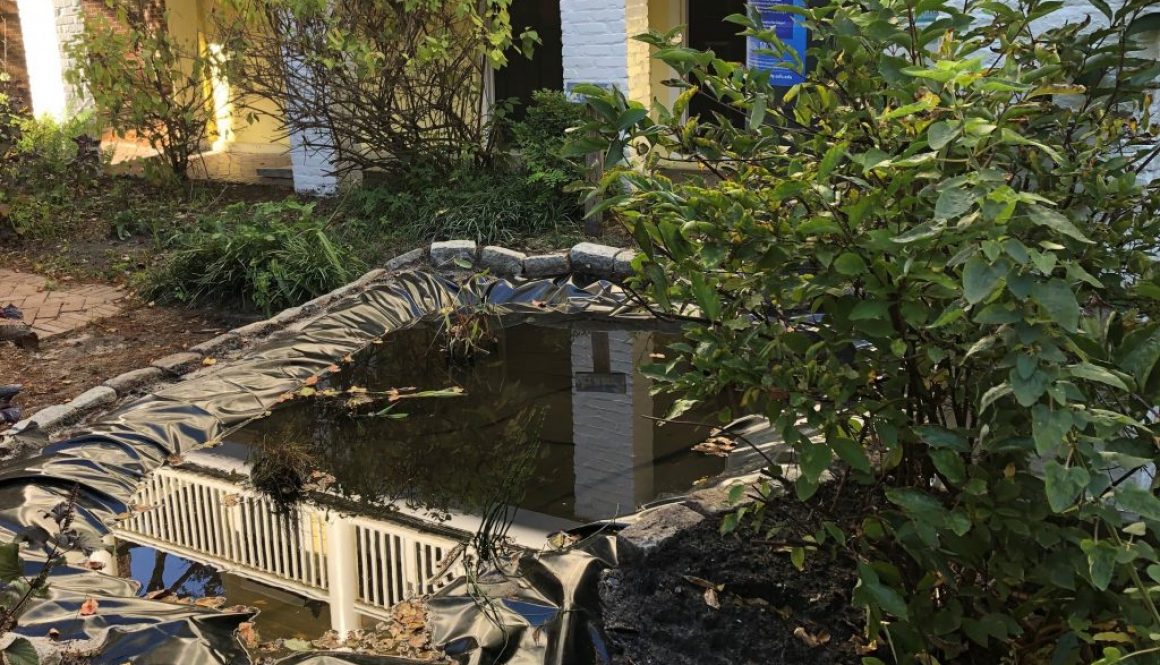The College of Charleston Completes Rain garden
Author: Sophie Spiegel
Photo by Sustainable Agriculture Intern Angus Mullis-McCord
In a quiet alcove nestled between the Women’s and Gender Studies Department and Rita Liddy Hollingsworth Science Center sits the College’s newly refurbished rain garden. Angus Mullis-McCord, an intern for the Sustainable Agricultural Program and the landscape designer for this project, was kind enough to give me a tour. He describes the multipurpose area as both a serene study spot for students and a sustainable solution to revitalize the presence of native plants and mitigate flooding on campus.
During downtown garden workdays, student volunteers and sustainable agriculture interns worked together to replant and revitalize the area. The Tetris shaped garden now features a variety of colorful shrubs surrounding a newly constructed retention pond. Beyond the pond, a shallow trench is flanked by more native plant species. Behind the pond is a rainwater collection barrel that was installed during a 2017 collaboration between the Center for Sustainable Development and the Clemson Cooperative Extension as a part of the College’s #WaterYouThinking “CofC Sustains/Solves” theme of the year.
The refurbished strategic design allows both the barrel and pond to capture and prevent urban water runoff. Any overflow from the pond will stream into the trench, which acts as a wetland area. This enables the plants to absorb the water, and any excess seeps into the groundwater.
Mullis-McCord explained that, “There’s a problem in cities where much ground area is covered by impermeable surfaces like asphalt and roofs. The water from rain events cannot percolate into the water table and replenish the source used for wells. In Charleston what happens is there is an increase in flooding because there’s nowhere for the water to go but up, so a rain garden allows the water to seep into the groundwater.”
As we strolled through the garden, Mullis-McCord pointed out some of South Carolina’s native plant species and their unique qualities, drawing from his bountiful knowledge of medicinal Native American ethnobotany. He paused at a tall rounded shrub known as Carolina All-spice or “Calicanthus floridus” he expertly identifies. The bark can be dried and used similarly to all-spice, hence the name reference. It also has a special relationship with the native sap beetle. In the spring, the plant’s fragrant flower attracts this beetle and then traps it amongst its pedals while the flower’s reproductive parts mature to ensure the insect picks up plenty of pollen. Once fully mature, the petals fold back to release the beetle allowing it to move in search of more food while successfully cross-pollinating.
Next, he stopped at the purple passionfruit flower. This plant has a symbiotic relationship with the gulf fritillary butterfly. Its fruits are edible and offer medicinal benefits like anxiety relief.
Then he pointed to Yaupon Holly, which to the untrained passerby just looks like an unremarkable decorative landscaped plant. In reality, it is actually the only native source of caffeine. Traditionally the plant was dried and used to make tea with a taste profile similar to yerba mate.
These are just a few of the native wetland species ecosystems that have been destroyed due to developers draining wetlands for agriculture and housing. The lack of native plant species also impacts the diversity of local insects that have evolved to have specialized interactions with a particular native species.
Mullis-McCord hopes to apply these principles of looking to indigenous teachings and permaculture techniques to create his own farm one day, but in the meantime, he hopes the garden will educate students on the incredible edible native species that are a part of this region’s history that have been neglected and underappreciated for years. He also points out that this garden is a way to “show that you can have a local food system that feeds a lot of people with very efficient use of land that doesn’t destroy the ecology.”
This garden can serve as a small part of the solution by recreating a wetland habitat. It’s time that our landscaping goes beyond aesthetics and serves as a means to give back to the environment by offering a haven to native insects and reducing flooding, offering multiple benefits to social, economic, and environmental systems.
About the Author:
Sophie Spiegel was the Student Engagement Intern for the CSD for Fall 2020 and she is a senior at the College majoring in Public Health.
